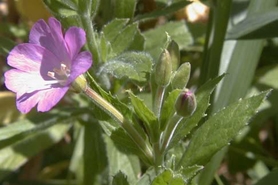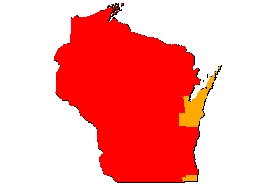Hairy willow herb
(Epilobium hirsutum)
A semi-aquatic perennial herb that grows 3-6' tall, with fine, soft hairs covering the entire plant. Stems are tall and branching. Grows in open, moist habitats.
Other names for this plant include:
- Common names: codlins and cream, European fireweed, excellent willow herb.
Classification in Wisconsin: Prohibited/Restricted (Restricted in Brown, Calumet, Door, Kenosha, Kewaunee, and Manitowoc counties; Prohibited elsewhere).
- Ecological Threat
-
- It forms dense, monotypic stands in open riparian areas along streams, ditch banks, wetlands and moist waste places.
- It can be found in undisturbed natural areas due to the seed quickly spreading by wind, water or transported by humans or animals.
- Identification
-
Leaves: Opposite and stalkless, with sharply toothed edges and a prominent central vein. They are oblong-lance shaped, 2-5" long and most expansive below the mid-point.
Flowers: Numerous 0.75" wide, rose-colored flowers arise from the leaf axils. Each flower has four notched petals, four sepals and a white four-lobed stigma rising above the bloom—blooms in mid-late summer.
Fruits & seeds: Fruit is a 2-3" long, tubular capsule containing many tiny, oblong, flattened seeds, each with a tuft of silky white hairs aiding wind dispersal.
Roots: Large root system with branching rhizomes that grow up to 2' long.
Similar species: Native fireweed (Epilobium angustifolium) can be distinguished from hairy willow herb by its alternate leaves and multiple stalked flowers arranged in a terminal raceme.
- Control
-
Mechanical: Hand pulls or digs, removing all plant parts. Mowing within three weeks of flowering can effectively eliminate annual seed production. Avoid control measures once the seed has matured.
Chemical: Foliar spray is a broad-spectrum herbicide that can translocate into roots and rhizomes, such as glyphosate or imazapyr.
- Resources
- Sources for content:
- Czarapata, Elizabeth; Invasive Plants of the Upper Midwest: an illustrated guide to their identification and control. The University of Wisconsin Press. 2005. Pg. 135
- Invasive Plant Atlas of New England: Hairy willow-herb [exit DNR].



